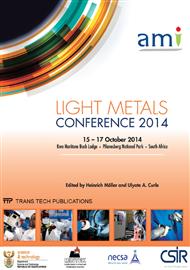p.126
p.133
p.143
p.152
p.160
p.169
p.177
p.187
p.195
Fundamental Differences between Magnesium and Alkali Metal Electrowinning
Abstract:
In the Kroll and Hunter processes to produce titanium from TiCl4, magnesium and sodium are used respectively as reducing agents. These processes are slow and very energy intensive and consequently much work was done over the years to improve the economics of producing these metals. In this regard, more success has been achieved with improving the economics of magnesium electrowinning than with alkali metal electrowinning. Magnesium electrowinning cells generally have electrodes with a planar shape and alkali metal electrolysis cells have electrodes with a cylindrical shape. Furthermore, recent advances in magnesium electrolysis allowed the introduction of bipolar electrodes, whereas such electrodes have not been introduced in alkali metal electrowinning cells. It is conceptually possible to replicate the advances in the construction of magnesium electrowinning cells to improve sodium or other alkali metal electrowinning cells. However, there are underlying fundamental reasons why it would be difficult to do so.In this paper the technologies for magnesium and alkali metal electrowinning cells are briefly reviewed. The reasons why it would be difficult to copy the improvements made in magnesium electrowinning technology to alkali metal electrowinning technology are then explained in terms of the implications of the underlying chemical and physical properties of the chemicals involved in the processes.
Info:
Periodical:
Pages:
160-168
Citation:
Online since:
October 2014
Authors:
Keywords:
Price:
Сopyright:
© 2014 Trans Tech Publications Ltd. All Rights Reserved
Share:
Citation:


